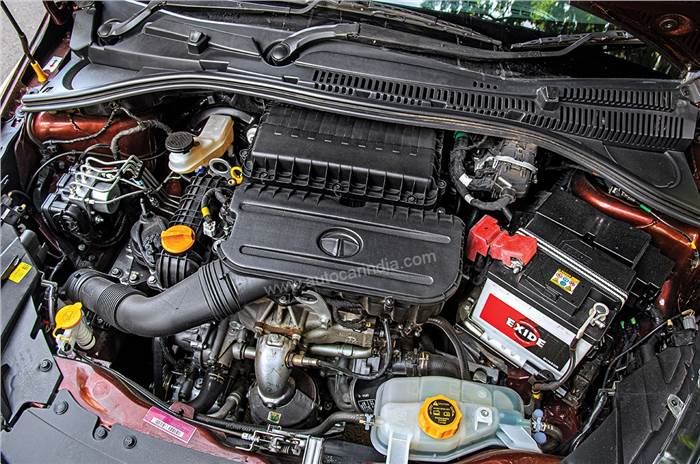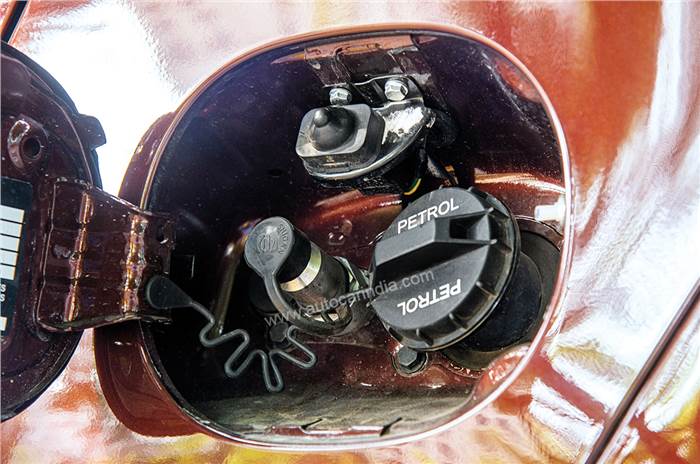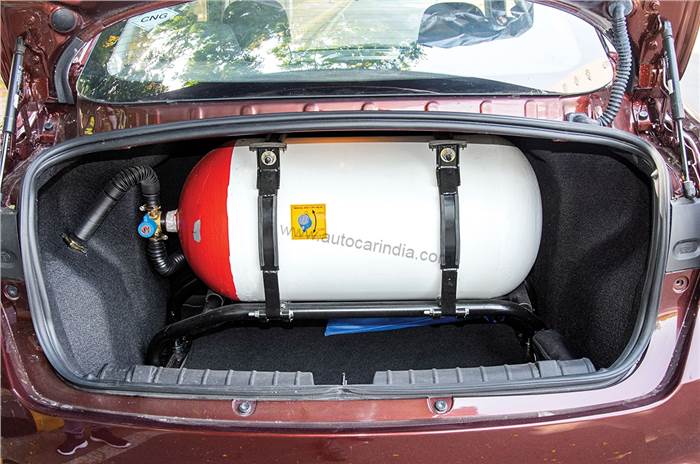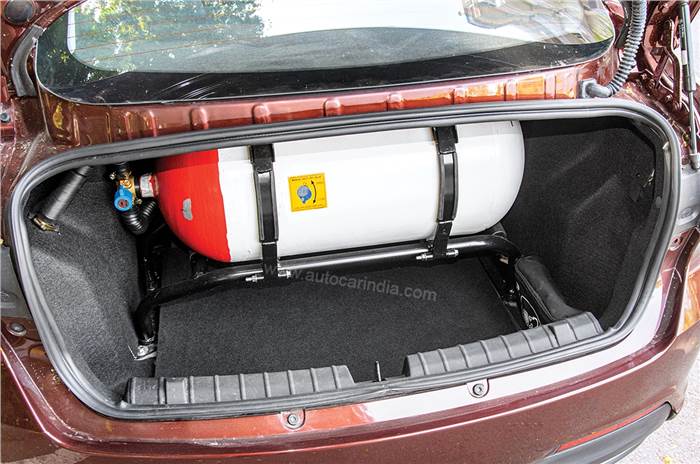2022 Tata Tigor iCNG review, road test
This all-new iCNG variant sits between the petrol and electric Tigor in terms of price. We find out how economical it is to run.
Published on Jun 11, 2022 08:00:00 AM
55,521 Views
Follow us on
The 1.2-litre non-turbo engine gives users the flexibility to run either on petrol or compressed natural gas. With the BS6 iteration of the Tigor, Tata made some tweaks to this engine and modified its final drive ratio for shorter overall gearing than the BS4 iteration, to enhance acceleration and drivability. The company has carried over the tune and gearing in this iCNG version, so it still produces 86hp and 113Nm of torque. And even though it is 100kg heavier than the standard petrol car, its drivability and engine character feel quite familiar.
 There isn’t a perceptible performance deficit in CNG mode.
There isn’t a perceptible performance deficit in CNG mode.
The three-cylinder engine isn’t devoid of vibrations and you can feel it flutter on its mounts at idle, although these do smoothen out on the move. Refinement levels are acceptable, and it only sounds thrummy when spun harder. What’s nice is that this engine feels sufficient for the daily urban grind and does reasonably well to keep pace with the flow of traffic on the highway. It is an able commuter, but responses could have been sharper.
 There are two dedicated gauges, one for CNG, other for petrol.
There are two dedicated gauges, one for CNG, other for petrol.
Also, due to a flattish mid-range, any drop in speed will warrant a downshift or two to regain momentum. While its lethargic 17.25sec 0-100kph time will hardly matter to owners, its overall average fuel economy of 12.7kpl is a number that will certainly leave owners yearning for better fuel efficiency. What’s interesting is that, by default, the Tigor starts in CNG mode. Only during chilly winters, when coolant temperatures drop below 20degC, the engine will start on petrol first and automatically switch to CNG once it reaches optimum running conditions.
 By default, it starts in CNG mode; users can switch modes on the fly.
By default, it starts in CNG mode; users can switch modes on the fly.
Tata claims that drivability doesn’t feel compromised in CNG mode. One of the measures adopted are high-pressure 4 bar injectors that enhance combustibility and performance compared to the commonly used 2 bar set-ups. We’re happy to report that their efforts have paid off, and even though this engine makes just 73hp and 95Nm of torque in CNG mode, the difference in day-to-day driving is indistinguishable. Some flat spots and inconsistencies across the rev band felt in petrol mode are nicely smoothened while running on CNG, and power delivery also feels much cleaner. In addition to a smoother drive experience in CNG, the engine also emits significantly lesser greenhouse gases and negligible particulate matter compared to petrol.
 In the interest of safety, the engine will not crank if the fuel flap is open.
In the interest of safety, the engine will not crank if the fuel flap is open.
For academic purposes, the CNG’s performance deficit is only noticeable when driving flat-out from 0-100kph, where it takes a second more than the petrol. A majority of CNG buyers will almost never venture into the full throttle or high-revving territory throughout their ownership, and hence won’t feel any performance deficit in CNG. What came as a surprise to us were its in-gear acceleration timings from 20-80kph in third gear and 40-100kph in fourth gear, which are identical to the petrol, despite the 15 percent torque disadvantage.
 60-litre tank accommodates around 10kg of compressed natural gas.
60-litre tank accommodates around 10kg of compressed natural gas.
Shifting focus to a matter of greater interest – its efficiency. The CNG delivers 16.85km per kg in the city and 25.86km per kg on the highway, the latter almost matching the company’s claimed 26.49km per kg figure. Not only does a kilo of CNG cost around 60 percent less than petrol (Rs 72 per kg versus Rs 111 per litre in Mumbai), the average running cost of CNG works out to Rs 3.3 per km, which is almost a third of petrol’s Rs 9.6 per km.
The Tigor’s tank accommodates around 10kg of gas, resulting in a real-world range of around 170km in the city, and 260km on the highway on a full tank of CNG. Owners will have to make peace with long queues at CNG pumps, due to limited stations, and an ever-increasing number of CNG users.

The Tigor iCNG competes with the Hyundai Aura CNG and Maruti Dzire CNG. While we haven’t put the competition through our tests, Hyundai and Maruti Suzuki claim efficiency of 28.4km per kg and 31.12km per kg of CNG, respectively, which are higher than Tata’s claim of 26.49km per kg. The Aura too has a larger 65-litre tank (versus the Tigor’s 60 litres), resulting in a longer travel range on a tankful of CNG. On the other hand, the Dzire’s tank is smaller, at 55 litres, but it weighs 130kg lesser than the Tigor. And owners claim to achieve far greater efficiency numbers than our Tigor iCNG’s real-world numbers.
 Usable space is halved from 419l to 205l, leaving enough room for two soft bags.
Usable space is halved from 419l to 205l, leaving enough room for two soft bags.
Copyright (c) Autocar India. All rights reserved.



Comments
Member Login
Personal Details
No comments yet. Be the first to comment.